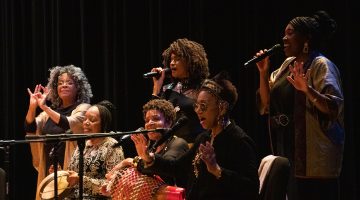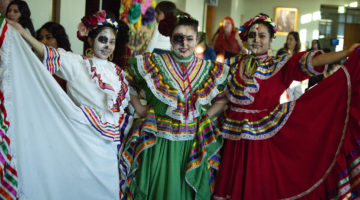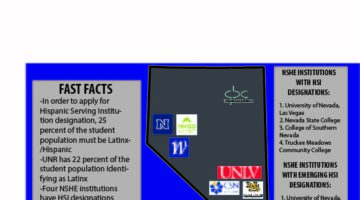
Jazmin Orozco/Nevada Sagebrush. A stack of lotería cards sits at a table during Lotería Night on Wednesday, Sept. 26. The game is often referred to as “Mexican bingo” for its similarity.
Lotería is a piece of home to Mexican communities throughout the United States. On Wednesday, Sept. 26, the Joe Crowley Student Union hosted Lotería Night at to celebrate Hispanic Heritage Month, nationally recognized from Sept. 15 to Oct. 15 every year. Both Hispanic and non-Hispanic students gathered to eat pupusas, enchiladas, and tacos from Chavelita’s Cocina Mexicana and play the Mexican “bingo” game, while listening to a variety of Latinx music genres.
Among the students present was UNR freshman Jared Stirling. Stirling was playing loteria for the first time that night with the intention of experiencing a piece of Hispanic culture.
“It’s nice to experience other cultures in a non-biased way,” he said, explaining the significance of events like Lotería Night. “I just don’t know much because I’m not part of that culture and I think it’s interesting to be able to see it and try not to appropriate, especially with how much that happens, but to see it from the perspective where that culture is in charge of showing their own culture,” he said.
While the event did not have offer any educational background on Hispanic/Latinx culture or the game of lotería itself, students present really seemed to enjoy themselves while trying to keep up with the game’s announcer and fill up their tablas, or game boards.
Lotería is often referred to as the Mexican version of “bingo” because it is very similar to the American game. Each player has their own game board, a colorful board full of a variety of different cultural images, such as “La Bandera”, the flag. An announcer is tasked with pulling cards of images from a stack, just like the bingo announcers pull ping pong balls, and state the given numbers.
“El Mundo! La Luna! La Sirena!”
The players mark the corresponding images on their boards to the ones announced with uncooked beans and, depending on circumstance, once the board is full of beans, they yell “Loteria!” and are declared winners of the game, sometimes winning a cash pot.
The game can be traced back to 15th century Spain and arrived in Mexico by way of colonization. Since the game was introduced to Mexican culture, many versions of the game have come and gone, but the most popular and commercial version is the “Don Clemente Gallo” that was introduced by French businessman Don Clemente Jacques in 1887. Today, this traditional version can be found on Amazon, Etsy, and its image is posted all over social media accounts and even tattooed onto people’s bodies.
This long-standing model of the game and its images have lasted for the past three generations and over 100 years. From the time that I was younger and playing the game with my own family, its popularity waned until recently.
The rise of social media and the Latinx millennial generation have influenced the recent catapult of lotería into mainstream popularity and are transforming the images to be more relevant after staying the same for generations.
Mike Alfaro is just one creator of a new lotería, the “Millennial Lotería.” This version includes millennial specific images, such as “La Debt Student,” “El Global Warming,” and “Tinder,” according to Araceli Cruz in an article for Brit + Co (article no longer available).
“I consider myself a product of globalization. I grew up in Guatemala for 17 years, but I watched everything from The Simpsons to Friends on cable. American TV had a big influence on me. So I think it’s no surprise that the work I create is both Latino and American. It’s just a reflection of who we are today, not the old stereotypes of yesterday,” Alfaro explains to Cruz as the significance for updating the outdated game.
Lotería is, and has been for over 100 years, a beloved cultural symbol and experience. Today, its existence ties entire generations of Mexican immigrants in the U.S. to their families and communities, near and far. Furthermore, its current transformation depicts the cultural shifts that are being lived and lead by the Latinx Millennial generation, creating a more relevant image that represents the fusion of being Latinx-American.











